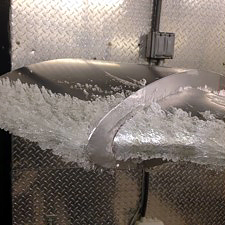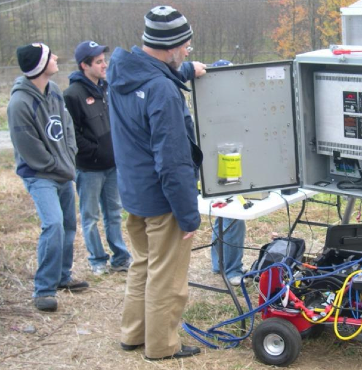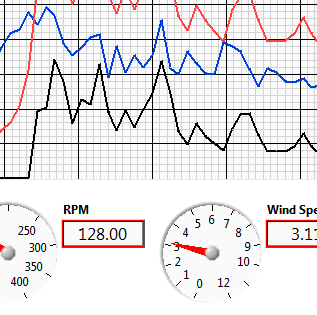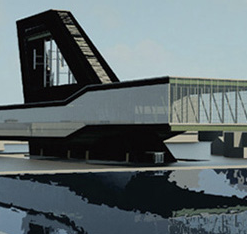Research
Projects

Wind Turbine Blade Icing
Modeling (contact: Sven Schmitz)
Adverse Environment Rotor Test Stand (contact: Jose Palacios)

Wind Turbine Research & Development Facility
Wind Turbine R&D and Performance Test Facility (contact: Rick Auhl & Susan Stewart)

Skystream Wind Turbine
View live feed from Skystream Wind Turbine on the Penn State Campus! (currently not sending a live image – please check back later!)

Building-Integrated Wind Energy
Building-Integrated Wind Energy: Connecting Aesthetics and Performance (contact: Ute Poerschke)
Student Theses / Reports
Evelyn Bateman – Impacts of the Clean Power Plan on Electricity Prices and Renewable Energy Development. B.S. Energy Engineering, Honors, Spring 2016. (Currently pursuing Masters in Wind Energy at DTU)
Pankaj Jha – Characterization of wake turbulence in a wind turbine array submerged in atmospheric boundary layer flow. PhD Aerospace Engineering, 2015. (Currently Senior Researcher Envision Energy)
Brian Wallace – Small Wind Turbine Performance Evaluation Using Field Test Data and a Coupled Aero-Electro-Mechanical Model, Ph.D. Aerospace Engineering, 2015. (Currently Senior Engineer at Sikorsky Aircraft)
Nicholas Ward – A Turbulence Intensity Similarity Distribution for Evaluating the Performance of a Small Wind Turbine in Low Wind Speed Regimes, M.S. in Energy & Mineral Engineering, 2015. (Currently pursuing Ph.D. in Wind Energy at Texas Tech)
Peter Blasco – Ice Accretion Experiments and Wind Tunnel Investigation of Iced Wind Turbine Airfoil, M.S. in Aerospace Engineering, Aug. 2015. (Currently Guidance, Navigation and Controls Engineer at Boeing)
Neel Sheth – Performance Evaluation of the Whisper – 500 Wind Turbine, MEng, Aerospace Engineering, Spring 2015. (Currently Wind Power Applications Engineer at Mersen)
Christine Lihn – Aerodynamic Testing of Micro-Scale Wind Turbines, M.S., Aerospace Engineering, Spring 2015.
Bridget Dougherty, Developing a Business Plan for a Small Scale Wind Turbine. B.S. Energy Business Finance, Honors, Spring 2014. (Currently Investment Analyst at GE Energy Financial Services)
Anagha Ray – Performance Study of a Small Scale Wind Turbine, Masters, Aerospace Engineering, 2014. (Currently Wind Energy Project Engineer at Intertek)
Allison Boehm – Wind Turbine Decommissioning Costs. M.S. Energy & Mineral Engineering, Dec. 2013. (Currently Director of St. Francis University Institute for Energy).
Dwight Brillembourg – Aerodynamic Performance of Wind Turbines under Atmospheric Icing Conditions. M.S. Aerospace Engineering, Aug. 2013. (Currently Lead Flight Dynamics/Controls Engineer at Avid LLC)
Kylie Flickinger – Facility Development For Testing Small Scale Horizontal Axis Wind Turbines, M.S. Aerospace Engineering, Aug. 2013.
Jessica Bashioum, Modeling the Wakes of Wind Turbines Using the Actuator Disc and Actuator Line Methods, B.S. Aerospace Engineering, May, 2013.
Josh Dowler – A New Stall-Delay Model for Horizontal Axis Wind Turbines. M.S. Aerospace Engineering, May 2013. (Currently Aerospace Engineering with NAVAIR)
Lucie Barj – Modeling and Analysis of a Semi-submersible Offshore Wind Turbine. M.S. Energy & Mineral Engineering, Aug. 2013. (Currently Offshore Site Specific Assessment Engineer at GE Renewable Energy)
Brian Wallace – Development and Validation of a Wind Generator Field Testing Methodology, Masters, Aerospace Engineering, 2011. (Completed PhD, see above)
Brenton Forshey – Health Monitoring Applications for Small Wind Turbines, Masters, Aerospace Engineering, 2011. (Currently Flight Test Engineer at Boeing)
Thomas Purcell, Blade Element Momentum Theory Applied to Horizontal Axis Wind Turbines. B.S. Aerospace Engineering, Spring 2011.
Leonardo Albanese – Adaptive Geometry Wind Turbine Blades for Increasing Performance. M.S. Aerospace Engineering, Aug. 2010. Currently: Mechanical Engineer at Lockheed Martin Corporation)
Penn State Capabilities
Turbulence in the atmosphere is an important influence on wind turbine performance. Two programs centered in the Department of Mechanical Engineering are developing high performance computing prediction methods to predict and analyze the consequences of turbulence on turbine loadings and mitigation strategies to reduce damaging transients. A collaboration among researchers in Mechanical Engineering, Aerospace Engineering, the Applied Research Lab, and the National Center for Atmospheric Research developed a “Cyber Wind Facility” for wind turbine and wind farm evaluation using the latest technologies in numerical methods and computational power, integrated with field experiments.
Researchers in our Department of Meteorology investigate fundamental questions in atmospheric physics, and have the capabilities to address issues related to wind resource assessment, prediction of boundary-layer turbulence and wind shear, siting, and supply-side forecasting. In collaboration with other researchers in Engineering and at the Penn State Applied Research Laboratory, they are also developing and using ground-based SODAR, RASS, LIDAR, and sonic anemometers for remote sensing of atmospheric properties and flow. In research for the U.S. Federal Aviation Administration (FAA), aerospace engineering researchers have also used RASS for wake-turbulence sensing at airports.
Faculty in the College of Earth and Mineral Sciences and the College of Agricultural Sciences, investigate the community implications of renewable energy. Faculty are engaged in providing technical assistance to communities considering energy-related development.
Penn State is home to a major Vertical Lift Research Center of Excellence (VLRCOE, also “ Rotorcraft Center”), one of only two in the U.S. led by the Department of Aerospace Engineering, with partners in the Applied Research Laboratory and the Composites Manufacturing Technology Center, researchers develop rotary-wing vehicle technology that is very relevant to wind energy systems. Rotating composite blades and highly-stressed drivetrains are common to helicopters, ships, and wind turbines, and are critical elements from the points of view of performance, reliability, and noise. The multidisciplinary design, analysis, and testing of a wind turbine has more than superficial similarity to that undertaken for a flight vehicle. Data-driven loads analysis, integrated design analysis, appropriate factors of safety, and extensive testing are the keys to long-term reliability, and Penn State has expertise in each of those areas.
Penn State’s Applied Research Laboratory (ARL) serves as a university center of excellence in defense science and technologies, with a focus on prototype demonstration systems. Researchers from several parts of ARL have capabilities relevant to wind energy. These include the Energy Science and Power Systems Division, the Drivetrain Technology Center, the Composite Materials Division, and Complex Systems Monitoring & Automation.